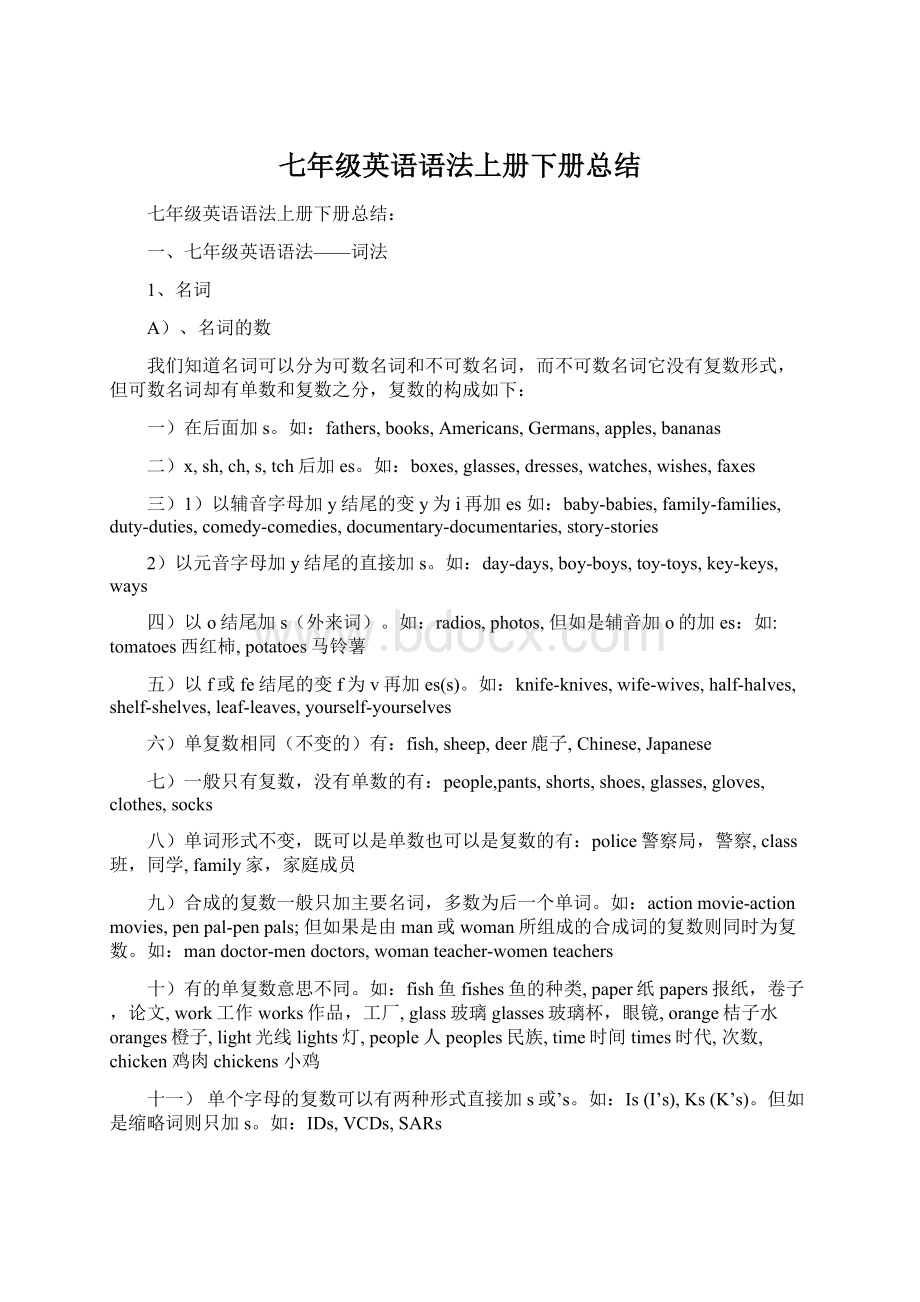七年级英语语法上册下册总结.docx
《七年级英语语法上册下册总结.docx》由会员分享,可在线阅读,更多相关《七年级英语语法上册下册总结.docx(13页珍藏版)》请在冰豆网上搜索。

七年级英语语法上册下册总结
七年级英语语法上册下册总结:
一、七年级英语语法——词法
1、名词
A)、名词的数
我们知道名词可以分为可数名词和不可数名词,而不可数名词它没有复数形式,但可数名词却有单数和复数之分,复数的构成如下:
一)在后面加s。
如:
fathers,books,Americans,Germans,apples,bananas
二)x,sh,ch,s,tch后加es。
如:
boxes,glasses,dresses,watches,wishes,faxes
三)1)以辅音字母加y结尾的变y为i再加es如:
baby-babies,family-families,duty-duties,comedy-comedies,documentary-documentaries,story-stories
2)以元音字母加y结尾的直接加s。
如:
day-days,boy-boys,toy-toys,key-keys,ways
四)以o结尾加s(外来词)。
如:
radios,photos,但如是辅音加o的加es:
如:
tomatoes西红柿,potatoes马铃薯
五)以f或fe结尾的变f为v再加es(s)。
如:
knife-knives,wife-wives,half-halves,shelf-shelves,leaf-leaves,yourself-yourselves
六)单复数相同(不变的)有:
fish,sheep,deer鹿子,Chinese,Japanese
七)一般只有复数,没有单数的有:
people,pants,shorts,shoes,glasses,gloves,clothes,socks
八)单词形式不变,既可以是单数也可以是复数的有:
police警察局,警察,class班,同学,family家,家庭成员
九)合成的复数一般只加主要名词,多数为后一个单词。
如:
actionmovie-actionmovies,penpal-penpals;但如果是由man或woman所组成的合成词的复数则同时为复数。
如:
mandoctor-mendoctors,womanteacher-womenteachers
十)有的单复数意思不同。
如:
fish鱼fishes鱼的种类,paper纸papers报纸,卷子,论文,work工作works作品,工厂,glass玻璃glasses玻璃杯,眼镜,orange桔子水oranges橙子,light光线lights灯,people人peoples民族,time时间times时代,次数,chicken鸡肉chickens小鸡
十一)单个字母的复数可以有两种形式直接加s或’s。
如:
Is(I’s),Ks(K’s)。
但如是缩略词则只加s。
如:
IDs,VCDs,SARs
十二)特殊形式的有:
child-children,man-men,woman-women,foot-feet,mouse-mice,policeman-policemen,Englishman-Englishmen
B)名词的格
当我们要表示某人的什么东西或人时,我们就要使用所有格形式。
构成如下:
一)单数在后面加’s。
如:
brother’s,Mike’s,teacher’s
二)复数以s结尾的直接在s后加’,如果不是以s结尾的与单数一样处理。
如:
Teachers’Day教师节,classmates’;Children’sDay六一节,Women’sDay三八节
三)由and并列的名词所有时,如果是共同所有同一人或物时,只加最后一个’s,但分别拥有时却分别按单数形式处理。
如:
MikeandBen’sroom迈克和本的房间(共住一间),Mike’sandBen’srooms迈克和本的房间(各自的房间)
2、代词
项目人称代词物主代词指示代词反身代词
人称主格宾格形容词名词性
第一人称单数Imemyminemyself
复数weusouroursourselves
第二人称单数youyouyouryoursyourself
复数youyouyouryoursyourselves
第三人称单数sheherherhersherself
hehimhishishimself
itititsitsthisthatitself
复数theythemtheirtheirsthesethosethemselves
3、动词
A)第三人称单数
当动词是第三人称单数时,动词应该像名词的单数变动词那样加s,如下:
一)一般在词后加s。
如:
comes,spells,waits,talks,sees,dances,trains
二)在x,sh,ch,s,tch后加es。
如:
watches,washes,wishes,finishes
三)1)以辅音字母加y结尾的变y为i再加es。
如:
study-studies,hurry-hurries,try-tries
2)以元音字母加y结尾的直接加s。
如:
plays,says,stays,enjoys,buys
四)以o结尾加es。
如:
does,goes
五)特殊的有:
are-is,have-has
B)现在分词
当我们说某人正在做什么事时,动词要使用分词形式,不能用原形,构成如下:
一)一般在后加ing。
如:
spell-spelling,sing-singing,see-seeing,train-training,play-playing,hurry-hurrying,watch-watching,go-going,do-doing
二)以不发音e的结尾的去掉e再加ing。
如:
dance-dancing,wake-waking,take-taking,practice-practicing,write-writing,have-having
三)以重读闭音节结尾且一个元音字母+一个辅音字母(注意除开字母组合如show–showing,draw-drawing)要双写最后的辅音字母再加ing。
如:
put-putting,run-running,get-getting,let-letting,begin-beginning
四)以ie结尾的变ie为y再加ing。
如:
tie-tying系die-dying死lie-lying位于
4、形容词的级
我们在对两个或以上的人或物进行对比时,则要使用比较或最高级形式。
构成如下:
一)一般在词后加er或est(如果是以e结尾则直接加r或st)。
如:
greater-greatest,shorter–shortest,taller–tallest,longer–longest,nicer-nicest,larger-largest
二)以重读闭音节结尾且1个元音字母+1个辅音字母(字母组合除外,如few-fewerfewest)结尾的双写结尾的辅音再加er/est。
如:
big-biggerbiggest,red-redderreddest,hot-hotterhottest
三)以辅音字母+y结尾的变y为i加er/est。
如:
happy-happierhappiest,sorry-sorriersorriest,friendly-friendlierfriendliest(morefriendlymostfriendly),busy-busierbusiest,easy-easiereasiest
四)特殊情况:
(两好多坏,一少老远)
good/well-betterbestmany/much-moremostbad/ill–worseworst
little-lessleastold-older/elderoldest/eldestfar-farther/furtherfarthest/furthest
5、数词(基变序,有规则;一、二、三,自己背;五、八、九、十二;其它后接th;y结尾,变为i,eth跟上去。
)first,second,third;fifth,eighth,ninth,twelfth;seventh,tenth,thirteenth,hundredth;twenty-twentieth,forty-fortieth,ninety-ninetieth
二、七年级英语语法——句式
1.陈述句
肯定陈述句a)Thisisabook.(be动词)
b)Helooksveryyoung.(连系动词)
c)Iwantasweatlikethis.(实义动词)
d)Icanbringsomethingstoschool.(情态动词)
e)There’sacomputeronmydesk.(Therebe结构)
否定陈述句a)Thesearen’ttheirbooks.b)Theydon’tlooknice.
c)Katedoesn’tgotoNo.4MiddleSchool.d)Katecan’tfindherdoll.
e)Thereisn’tacathere.(=There’snocathere.)
2.祈使句
肯定祈使句a)Pleasegoandasktheman.b)Let’slearnEnglish!
c)Comein,please.
否定祈使句a)Don’tbelate.b)Don’thurry.
3.疑问句
1)一般疑问句a)IsJimastudent?
b)CanIhelpyou?
c)Doesshelikesalad?
d)DotheywatchTV?
e)Isshereading?
肯定回答:
a)Yes,heis.b)Yes,youcan.c)Yes,shedoes.d)Yes,theydo.e)Yes,sheis.
否定回答:
a)No,heisn’t.b)No,youcan’t.c)No,shedoesn’t.d)No,theydon’t.e)No,sheisn’t.
2)选择疑问句Isthetablebigorsmall?
回答It’sbig./It’ssmall.
3)特殊疑问句
①问年龄HowoldisLucy?
Sheistwelve.
②问种类Whatkindofmoviesdoyoulike?
Ilikeactionmoviesandcomedies.
③问身体状况Howisyouruncle?
Heiswell/fine.
④问方式Howdo/canyouspellit?
L-doubleO-K.
Howdowecontactyou?
Mye-mailaddressiscindyjones@.
⑤问原因Whydoyouwanttojointheclub?
⑥问时间What’sthetime?
(=Whattimeisit?
)It’saquartertotena.m..
Whattimedoyouusuallygetup,Rick?
Atfiveo’clock.
Whendoyouwanttogo?
Let’sgoat7:
00.
⑦问地方Where’smybackpack?
It’sunderthetable.
⑧问颜色Whatcolorarethey?
Theyarelightblue.
What’syourfavouritecolor?
It’sblack.
⑨问人物Who’sthat?
It’smysister.
Whoistheboyinblue?
Mybrother.
Whoisn’tatschool?
PeterandEmma.
WhoareLisaandTimtalkingto?
⑩问东西What’sthis/that(inEnglish)?
It’sapencilcase.
Whatelsecanyouseeinthepicture?
Icanseesomebroccoli,strawberriesandhamburgers.
11问姓名What’syouraunt’sname?
HernameisHelen./She’sHelen.
What’syourfirstname?
Myfirstname’sBen.
What’syourfamilyname?
Myfamilyname’sSmith.
12问哪一个Whichdoyoulike?
Ilikeoneinthebox.
13问字母Whatletterisit?
It’sbigD/smallf.
14问价格Howmucharethesepants?
They’re15dollars.
15问电话号码What’syourphonenumber?
It’s576-8349.
16问谓语(动作)What’shedoing?
He’swatchingTV.
17问职业(身份)Whatdoyoudo?
I’mateacher.
What’syourfather?
He’sadoctor.
三、七年级英语语法——时态
1、一般现在时表示普遍、经常性的或长期性的动作时使用一般现在时,它有:
Be动词:
She’saworker.Issheaworker?
Sheisn’taworker.
情态动词:
Icanplaythepiano.Canyouplaythepiano?
Ican’tplaythepiano.
行为动词:
Theywanttoeatsometomatoes.Dotheywanttoeatanytomatoes?
Theydon’twanttoeatanytomatoes.
Ginahasanicewatch.DoesGinahaveanicewatch?
Ginadoesn’thaveawatch.
2、现在进行时表示动词在此时正在发生或进行就使用进行时态,结构为sbbev-ingsth+其它.
I’mplayingbaseball.Areyouplayingbaseball?
I’mnotplayingbaseball.
Nancyiswritingaletter.IsNancywritingaletter?
Nancyisn’twritingaletter.
They’relisteningtothepopmusic.Aretheylisteningthepopmusic?
Theyaren’tlisteningtothepopmusic.
一、词
(一)名词
1、名词的复数
(1)、一般的直接加s,如desk(desks)、pen(pens)、ruler(rulers)
(2)、以x、s、ch、sh结尾的加es如box(boxes)、class(classes)、watch(watches)等
(3)、以辅音字母加y结尾的要变y为i加es,如family,comedy,documentary等
(4)、以0结尾的名词,有生命的加es如:
tomato(tomatoes)、potato(potatoes);没有生命的加s,如
photo(photos)、piano(pianos)、zero(zeros)
2、名词所有格在名词的后边加’s,表示后面的名词属于前面的名词所有,如LiLei’sbagTom’sdesk、hermother’sbrother
3、专用名词的大写
如English、Brown、Rush、Sunday、January、December、BeijingOpera
(二)动词
1、动词的种类(四类)
系动词如be(isamare);情态动词如can、may、need;助动词(dodoes);行为动词如take、bring、eat、have(has)、like、sell、buy、sale、play、see、find、go、watch、thank、think等
2、动词的第三人称单数(与名词的复数一样)
如eat(eats)take(takes)buy(buys)play(plays)have(has)are(is)
3、动词的时态(一般现在时)
(1)含有系动词的
I’maChineseboy.
Sheistwelve.
HeisTim’sbrother.
HermotherisanEnglishteacher.
含有系动词的句子在变一般疑问句时只将“主语和系动词交换位置”,上面句子变成一般疑问句时分别为
AreyouaChineseboy?
(注意第一人称通常变为第二人称)
Isshetwelve?
IsheTim’sbrother?
IshermotheranEnglishteacher?
含有系动词的句子在变否定句时只须“在系动词的后边加上not”,前面的几个了陈述句变否定句分别为
I’mnotaChineseboy.
Sheisn’ttwelve.
HeisnotTim’sbtother.
Hermotherisn’tanEnglishteacher.
(2)含有情态动词的句子(can),
Shecanplaybasketball.
Hismother’scousincansingmanyEnglishsongs.
含有情态动词的句子在变一般疑问句时只须将“主语和情态动词交换位置”,上面两句变一般疑问句分别为
Cansheplaybasketball?
Canhismother’scousinsingmanyEnglishsongs?
含有情态动词的句子在变否定句时直接在情态动词的后边加上not,上面两个陈述句变否定句分别为
Shecannotplaybasketball.
Hismother’scousincannotsingmanyEnglishsongs.
(3)含有行为动词的句子
Wehavemanyfriends.
TheywatchTVat7intheevening.
Thestudentstaketheirbookstoschool.
Ihavelunchatschool.
Youhaveasister.
含有行为动词的句子在变一般疑问句时要在原句子的前面加do.上面的句子变成一般疑问句分别为
Doyouhavemanyfriends?
DotheywatchTVat7intheevening?
Dothestudentstaketheirbookstoschool?
Doyouhavelunchatschool?
Doyouhaveasister?
含有行为动词的句子在变否定句时只须在行为动词前加don’t.上述五个陈述句变否定句分别为
Wedon’thavemanyfriends.
Theydon’twatchTVat7intheevening.
Thestudentsdon’ttaketheirbookstoschool.
Idon’thavelunchatschool.
Youdon’thaveasister.
含有行为动词的句子,当主语是第三人称单数时,行为动词要加s(或es)如:
Shehasaredpen.
Hehaseggsforbreakfast.
Hermotherbuysaskirtforher.
Shelikesthrillers.
MybrotherwatchesTVeveryevening.
Hewantstogotoamovie.
含有行为动词的句子,当主语是第三人称单数时,变一般疑问句要“在原句子的前面加上does,同时行为动词要还原”。
上面的句子变成一般疑问句分别为:
Doesshehavearedpen?
Doeshehaveeggsforbreakfast?
Doeshermotherbuyaskirtforher?
Doesshelikethrillers?
DoesyourbrotherwatchTVeveryevening?
Doeshewanttogotoamovie?
含有行为动词的句子,当主语是第三人称单数时,变否定句时“在行为动词前面加does’nt,同时原行为动词要还原”。
上面的句子变否定句分别为:
Shedoesn’thavearedpen.
Hedoesn’thaveeggsforbreakfast.
Hermotherdoesn’tbuyaskirtforher.
Shedoesn’tlikethrillers.
Mybrotherdoesn’twatchTVeveryevening.
Hedoesn’twanttogotoamovie.
(三)形容词
本册所学的形容词不多,注意拼法和反义词
big(small)long(short)sad(happy)boring(interesting\funny)excitingdifficult
relaxinggreathealthyold(new)successfulwhite(black)
(四)代词
1、人称代词和物主代词
人称代词
第一人称
第二人称
第三人称
单数
复数
单数
复数
单数
复